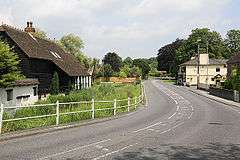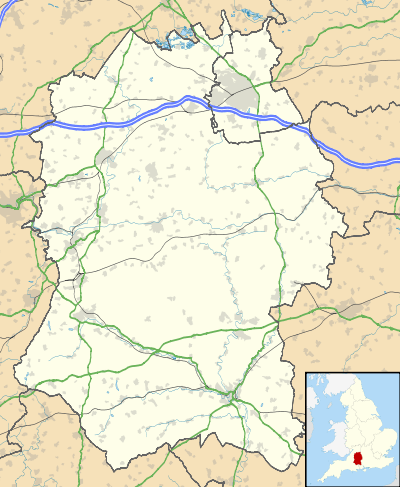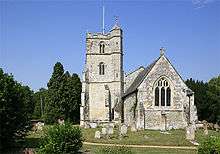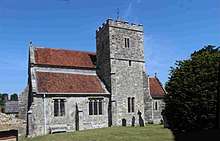Coombe Bissett
Coombe Bissett is a village and civil parish in the English county of Wiltshire in the River Ebble valley, 3 miles (4.8 km) southwest of Salisbury on the A354 road that goes south towards Blandford Forum.
| Coombe Bissett | |
|---|---|
 A354, Coombe Bissett | |
 Coombe Bissett Location within Wiltshire | |
| Population | 675 (in 2011)[1] |
| OS grid reference | SU109264 |
| Civil parish |
|
| Unitary authority | |
| Ceremonial county | |
| Region | |
| Country | England |
| Sovereign state | United Kingdom |
| Post town | Salisbury |
| Postcode district | SP5 |
| Dialling code | 01722 |
| Police | Wiltshire |
| Fire | Dorset and Wiltshire |
| Ambulance | South Western |
| UK Parliament | |
| Website | www |
The parish includes the village of Homington, to the east towards the village of Odstock.
History
Records from Saxon times indicate that the Ebble valley was a thriving area, the River Ebble also being known as the River Chalke.
The Domesday Book in 1086 divided the Chalke Valley into eight manors: Chelke (Chalke – Bowerchalke and Broadchalke), Eblesborne (Ebbesbourne Wake), Fifehide (Fifield Bavant), Cumbe (Coombe Bissett), Humitone (Homington), Odestoche (Odstock), Stradford (Stratford Tony and Bishopstone) and Trow (circa Alvediston).[2]
The Domesday Book also recorded Cumbe as a royal manor with 85 households,[3] while Humitone had just two households.[4]
A medieval packhorse bridge, now a footbridge, crosses the Ebble close to the current road bridge at Coombe Bissett.[5]
Coombe Bissett and Homington were separate parishes, each with its own church, until they were united in a joint benefice in 1885.[6]
Homington was absorbed into Coombe Bissett civil parish in 1934.[7]
Religious sites

The two Anglican churches below are served by the Chalke Valley team ministry.[8]
St Michael's, Coombe Bissett
The oldest part of St Michael's, the south aisle, is from the 12th century. The chancel was built in the 13th and the tower (with stair-turret) added in the 14th; the nave and north transept are 15th-century.
Restoration in 1845 by T.H. Wyatt included the rebuilding of the west front, reducing the length of the building.[9] The church is a Grade I listed building.[10]
St Mary's, Homington

St Mary's is a 14th-century church, possibly with earlier origins. The tower of the present church is from the early 17th century and there was extensive restoration in the 1860s. The church is a Grade II* listed building.[11]
Nonconformist chapels
A Primitive Methodist chapel was built in 1841 at the west end of Homington village, then rebuilt in 1877. The chapel closed in 1967 and is now a private house.[12]
In 1895 a Baptist chapel was opened at Coombe Bissett, on the road to Homington, and is used by the Coombe Fellowship.[13]
Amenities
Coombe Bissett has a pub, the Fox and Goose, a village hall, and a shop with a post office.
A primary school was built at Shutts Lane in the 1960s, replacing a small National School on the Homington road which was built in 1845.[14]
Homington and Coombe Bissett Downs is a nature reserve on nearby chalk downland.
There are various clubs within the village, including a tennis club, cricket club[15] and badminton club.
Salisbury and South Wiltshire Golf Course is to the north of the village.
Salisbury Hospital is to the east, north of Odstock village and a 10-minute drive from Coombe Bissett.
Bordering areas
References
- "Coombe Bissett Census Information". Wiltshire Community History. Wiltshire Council. Archived from the original on 19 December 2014. Retrieved 19 December 2014.
- Ebbesbourne Wake through the Ages by Peter Meers
- Coombe Bissett in the Domesday Book
- Homington in the Domesday Book
- Historic England. "Packhorse Bridge over River Ebble (1375630)". National Heritage List for England. Retrieved 30 April 2016.
- "No. 25456". The London Gazette. 31 March 1885. pp. 1459–1460.
- "Homington". A Vision of Britain through Time. University of Portsmouth. Retrieved 30 April 2016.
- "Our Churches". Chalke Valley Church. Archived from the original on 27 March 2016. Retrieved 30 April 2016.
- Pevsner, Nikolaus; Cherry, Bridget (revision) (1975) [1963]. Wiltshire. The Buildings of England (2nd ed.). Harmondsworth: Penguin Books. pp. 190–191. ISBN 0-14-0710-26-4.
- Historic England. "Church of St Michael (1023802)". National Heritage List for England. Retrieved 1 May 2016.
- Historic England. "Church of St Mary the Virgin (1023807)". National Heritage List for England. Retrieved 1 May 2016.
- "Homington Primitive Methodist Chapel". Wiltshire Community History. Wiltshire Council. Archived from the original on 5 August 2016. Retrieved 30 April 2016.
- "Baptist Chapel, Coombe Bissett". Archived from the original on 5 August 2016. Retrieved 30 April 2016.
- "Coombe Bissett Church of England Primary School". Wiltshire Community History. Wiltshire Council. Archived from the original on 5 August 2016. Retrieved 1 May 2016.
- https://sites.google.com/site/coombebissettcc/
External links
| Wikimedia Commons has media related to Coombe Bissett. |
| Wikimedia Commons has media related to Homington. |
- "Coombe Bissett". Wiltshire Community History. Wiltshire Council. Archived from the original on 4 August 2016. Retrieved 30 April 2016.
- Village website
- Acornley, Jennifer. "History of Coombe Bissett". www.coombebissett.com. Retrieved 30 April 2016.
- "History of St Michael and All Angels, Coombe Bissett". Chalke Valley Church. Archived from the original on 30 June 2016. Retrieved 1 May 2016.
- Acornley, Jennifer. "History of Homington". www.coombebissett.com. Retrieved 30 April 2016.
- "Homington Church History". Chalke Valley Church. Archived from the original on 30 June 2016. Retrieved 1 May 2016.